Abasic and oxidized ribonucleotides embedded in DNA are processed by human APE1 and not by RNase H2
- PMID: 28977421
- PMCID: PMC5737539
- DOI: 10.1093/nar/gkx723
Abasic and oxidized ribonucleotides embedded in DNA are processed by human APE1 and not by RNase H2
Abstract
Ribonucleoside 5'-monophosphates (rNMPs) are the most common non-standard nucleotides found in DNA of eukaryotic cells, with over 100 million rNMPs transiently incorporated in the mammalian genome per cell cycle. Human ribonuclease (RNase) H2 is the principal enzyme able to cleave rNMPs in DNA. Whether RNase H2 may process abasic or oxidized rNMPs incorporated in DNA is unknown. The base excision repair (BER) pathway is mainly responsible for repairing oxidized and abasic sites into DNA. Here we show that human RNase H2 is unable to process an abasic rNMP (rAP site) or a ribose 8oxoG (r8oxoG) site embedded in DNA. On the contrary, we found that recombinant purified human apurinic/apyrimidinic endonuclease-1 (APE1) and APE1 from human cell extracts efficiently process an rAP site in DNA and have weak endoribonuclease and 3'-exonuclease activities on r8oxoG substrate. Using biochemical assays, our results provide evidence of a human enzyme able to recognize and process abasic and oxidized ribonucleotides embedded in DNA.
© The Author(s) 2017. Published by Oxford University Press on behalf of Nucleic Acids Research.
Figures

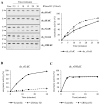
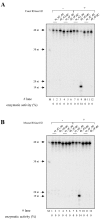
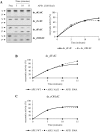
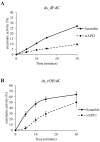
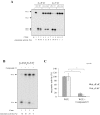
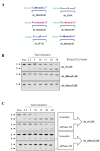
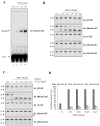
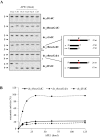
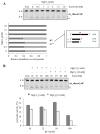
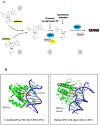
Similar articles
-
Unlike the Escherichia coli counterpart, archaeal RNase HII cannot process ribose monophosphate abasic sites and oxidized ribonucleotides embedded in DNA.J Biol Chem. 2019 Aug 30;294(35):13061-13072. doi: 10.1074/jbc.RA119.009493. Epub 2019 Jul 12. J Biol Chem. 2019. PMID: 31300556 Free PMC article.
-
Characterization of the endoribonuclease active site of human apurinic/apyrimidinic endonuclease 1.J Mol Biol. 2011 Sep 2;411(5):960-71. doi: 10.1016/j.jmb.2011.06.050. Epub 2011 Jul 6. J Mol Biol. 2011. PMID: 21762700 Free PMC article.
-
Altered APE1 activity on abasic ribonucleotides is mediated by changes in the nucleoside sugar pucker.Comput Struct Biotechnol J. 2021 May 25;19:3293-3302. doi: 10.1016/j.csbj.2021.05.035. eCollection 2021. Comput Struct Biotechnol J. 2021. PMID: 34188778 Free PMC article.
-
RNase H2-RED carpets the path to eukaryotic RNase H2 functions.DNA Repair (Amst). 2019 Dec;84:102736. doi: 10.1016/j.dnarep.2019.102736. Epub 2019 Oct 23. DNA Repair (Amst). 2019. PMID: 31761672 Free PMC article. Review.
-
RNases H1 and H2: guardians of the stability of the nuclear genome when supply of dNTPs is limiting for DNA synthesis.Curr Genet. 2020 Dec;66(6):1073-1084. doi: 10.1007/s00294-020-01086-8. Epub 2020 Sep 4. Curr Genet. 2020. PMID: 32886170 Free PMC article. Review.
Cited by
-
AUF1 Recognizes 8-Oxo-Guanosine Embedded in DNA and Stimulates APE1 Endoribonuclease Activity.Antioxid Redox Signal. 2023 Sep;39(7-9):411-431. doi: 10.1089/ars.2022.0105. Epub 2023 Apr 11. Antioxid Redox Signal. 2023. PMID: 36855946 Free PMC article.
-
Large-Scale Photolithographic Synthesis of Chimeric DNA/RNA Hairpin Microarrays To Explore Sequence Specificity Landscapes of RNase HII Cleavage.Biochemistry. 2019 Nov 5;58(44):4389-4397. doi: 10.1021/acs.biochem.9b00806. Epub 2019 Oct 28. Biochemistry. 2019. PMID: 31631649 Free PMC article.
-
Processing of matched and mismatched rNMPs in DNA by archaeal ribonucleotide excision repair.iScience. 2023 Nov 17;26(12):108479. doi: 10.1016/j.isci.2023.108479. eCollection 2023 Dec 15. iScience. 2023. PMID: 38077150 Free PMC article.
-
Intrinsic Strand-Incision Activity of Human UNG: Implications for Nick Generation in Immunoglobulin Gene Diversification.Front Immunol. 2021 Dec 22;12:762032. doi: 10.3389/fimmu.2021.762032. eCollection 2021. Front Immunol. 2021. PMID: 35003074 Free PMC article.
-
Hallmarks of DNA replication stress.Mol Cell. 2022 Jun 16;82(12):2298-2314. doi: 10.1016/j.molcel.2022.05.004. Mol Cell. 2022. PMID: 35714587 Free PMC article. Review.
References
-
- Randerath K., Reddy R., Danna T.F., Watson W.P., Crane A.E., Randerath E.. Formation of ribonucleotides in DNA modified by oxidative damage in vitro and in vivo. Characterization by 32P-postlabeling. Mutat. Res. 1992; 275:355–366. - PubMed
MeSH terms
Substances
Grants and funding
LinkOut - more resources
Full Text Sources
Other Literature Sources
Research Materials
Miscellaneous

